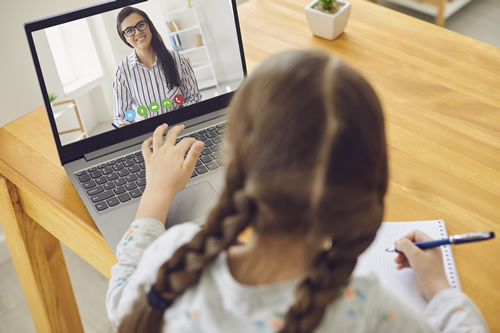Let’s face it: pandemic learning is stressful and exhausting.
There is truly no getting away from the fact that trying to engage in any activity that requires maximum brain activity (ahem: teaching and learning) is extra hard while we are trying to survive any kind of trauma. So it is imperative that we come up with ways to lighten our mental load in order to survive, much less thrive.
The news is reporting that teachers are not OK. Part of this comes from districts who were not willing to accept the reality that being consistently virtual is better in the long run than trying and failing at reopening for in-person instruction. Consequently, too many teachers have been put in the position of having to toggle back and forth between full in-person and full remote or even harder to manage hybrid learning where they are teaching kids both in-person and remotely, sometimes in the same day.
Here are some tips that you can use to make the whole hybrid learning process less overwhelming.
1. Record your in-person lessons.
Set up a computer or, if you have the hardware, a camera attached to your computer at the back of the room. Just before starting your in-person lesson, start a Zoom meeting and record your lesson. Be sure to focus on your smartboard or whiteboard- wherever you are standing.
If you can, use a good condenser microphone to pick up your voice and the voices of students asking questions and offering in-put clearly. I use an audio-technica 2020, which has a USB connection that plug right into your computer – no extra software! It cost me somewhere between $100-$150. Your students’ faces will not be in the recording unless you have them come up to the board. Then use this recorded lesson as the asynchronous support for your remote students. Have them watch the recording and then attend small group lessons where they can ask questions or work through additional problems with you. They will benefit from not just getting the presentation but from hearing other students’ questions and your answers to them.
2. Invite remote students to sit in on in-person classes through a stream.
If you are using Zoom, there is a setting that allows you to live stream to YouTube. You can either invite your students to simply join the Zoom meeting itself or invite them to watch the live stream on YouTube. If they join the Zoom meeting, just make sure they remember that you are going to be recording it. They can choose to keep their cameras off and you can set the camera settings to “Hide all non-video participants” so even their names will not appear in the recording if you are planning to use it later for asynchronous support. Just remember to use “Speaker View”.
3. Use interactive tools so that remote students can ask questions or participate during an in-person lesson.
If you already have a tool like ClassDoJo set up to communicate with your parents, invite your students to join you on the app. Most students in Middle and High School have their own devices and there is an option to access ClassDoJo via the web as well (although I personally have never gotten this to work from the parent side.) Then you can allow your remote students who might be listening in to ask questions about or contribute input to your in-person lessons via the messaging system without having your computer close enough to you to see the chat.
4. Make some digital activities available to both remote and in-person students simultaneously to bridge the gap.
Many, if not all, of your students will either have a device of their own (can be a smart phone) or a school-supplied Chromebook. If they can have them in the classroom, you can create digital interaction activities where they can work together with students who are at home. You can create a Zoom meeting and put them in breakout rooms or you can create activities where they all get to work on the same Google document, Google slides or other digital activity that is accessible from multiple devices at the same time, such as skribbl.io. This not only allows the remote learners to be doing the same work the in-person students are doing but also allows them to feel less isolated by getting to interact with them. We could all use a lot more of that!
Using these techniques will save you time and energy while also increasing equitable access to the classroom and all of its resources.
- 4 ways to encourage play in education - April 25, 2024
- CoSN IT Leader Spotlight: Lisa Higgins - April 25, 2024
- It’s time to pay student teachers - April 25, 2024


